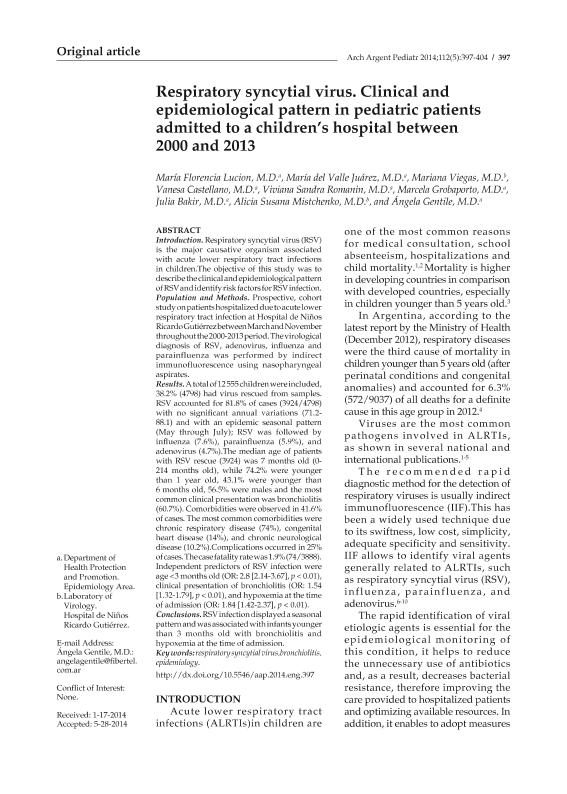Artículo
Respiratory syncytial virus: Clinical and epidemiological pattern in pediatric patients admitted to a children’s hospital between 2000 and 2013
Lucion, María Florencia; Juárez, María del Valle; Viegas, Mariana ; Castellano, Verónica; Romanin, Viviana Sandra; Grobaporto, Marcela; Bakir, Julia; Mistchenko, Alicia Susana; Gentile, Ángela
; Castellano, Verónica; Romanin, Viviana Sandra; Grobaporto, Marcela; Bakir, Julia; Mistchenko, Alicia Susana; Gentile, Ángela
 ; Castellano, Verónica; Romanin, Viviana Sandra; Grobaporto, Marcela; Bakir, Julia; Mistchenko, Alicia Susana; Gentile, Ángela
; Castellano, Verónica; Romanin, Viviana Sandra; Grobaporto, Marcela; Bakir, Julia; Mistchenko, Alicia Susana; Gentile, Ángela
Fecha de publicación:
05/2014
Editorial:
Sociedad Argentina de Pediatría
Revista:
Archivos Argentinos de Pediatría
ISSN:
0325-0075
e-ISSN:
1668-3501
Idioma:
Inglés
Tipo de recurso:
Artículo publicado
Clasificación temática:
Resumen
INTRODUCTION: Respiratory syncytial virus (RSV) is the major causative organism associated with acute lower respiratory tract infections in children.The objective of this study was to describe the clinical and epidemiological pattern of RSV and identify risk factors for RSV infection.
POPULATION AND METHODS: Prospective, cohort study on patients hospitalized due to acute lower respiratory tract infection at Hospital de Niños Ricardo Gutiérrez between March and November throughout the 2000-2013 period. The virological diagnosis of RSV, adenovirus, influenza and parainfluenza was performed by indirect immunofluorescence using nasopharyngeal aspirates.
RESULTS: A total of 12,555 children were included, 38.2% (4798) had virus rescued from samples. RSV accounted for 81.8% of cases (3924/4798) with no significant annual variations (71.2- 88.1) and with an epidemic seasonal pattern(May through July); RSV was followed by influenza (7.6%), parainfluenza (5.9%), and adenovirus (4.7%).The median age of patients with RSV rescue (3924) was 7 months old (0- 214 months old), while 74.2% were younger than 1 year old, 43.1% were younger than 6 months old, 56.5% were males and the most common clinical presentation was bronchiolitis (60.7%). Comorbidities were observed in 41.6% of cases. The most common comorbidities were chronic respiratory disease (74%), congenital heart disease (14%), and chronic neurological disease (10.2%).Complications occurred in 25%of cases. The case fatality rate was 1.9% (74/3888). Independent predictors of RSV infection were age <3 months old (OR: 2.8 [2.14-3.67], p < 0.01),clinical presentation of bronchiolitis (OR: 1.54 [1.32-1.79], p < 0.01), and hypoxemia at the time of admission (OR: 1.84 [1.42-2.37], p < 0.01).
CONCLUSIONS: RSV infection displayed a seasonal pattern and was associated with infants younger than 3 months old with bronchiolitis and hypoxemia at the time of admission.
Palabras clave:
Virus Sincicial Respiratorio
,
Epidemiología
,
Bronquiolitis
Archivos asociados
Licencia
Identificadores
Colecciones
Articulos(SEDE CENTRAL)
Articulos de SEDE CENTRAL
Articulos de SEDE CENTRAL
Citación
Lucion, María Florencia; Juárez, María del Valle; Viegas, Mariana; Castellano, Verónica; Romanin, Viviana Sandra; et al.; Respiratory syncytial virus: Clinical and epidemiological pattern in pediatric patients admitted to a children’s hospital between 2000 and 2013; Sociedad Argentina de Pediatría; Archivos Argentinos de Pediatría; 112; 5; 5-2014; 397-404
Compartir
Altmétricas



